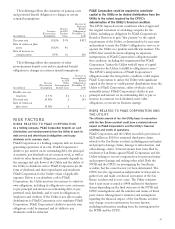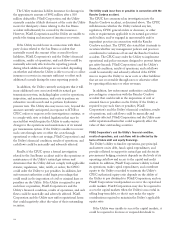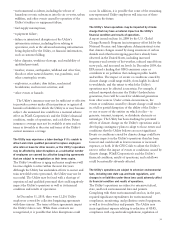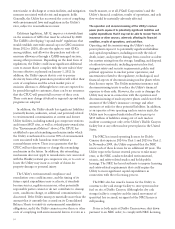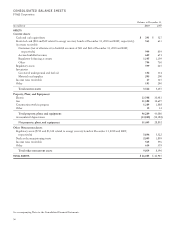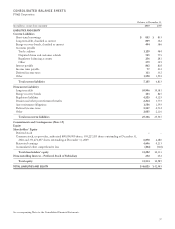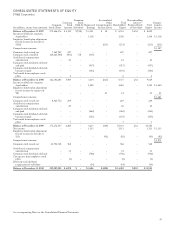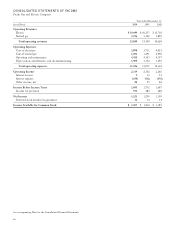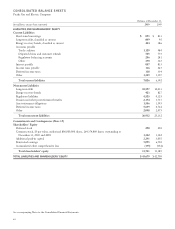PG&E 2010 Annual Report Download - page 56
Download and view the complete annual report
Please find page 56 of the 2010 PG&E annual report below. You can navigate through the pages in the report by either clicking on the pages listed below, or by using the keyword search tool below to find specific information within the annual report.water intake or discharge at certain facilities, and mitigation
measures associated with electric and magnetic fields.
Generally, the Utility has recovered the costs of complying
with environmental laws and regulation in the Utility’s
rates, subject to reasonableness review.
California legislation, AB 32, imposes a statewide limit
on the emission of GHG that must be achieved by 2020.
The CARB is developing “cap-and-trade” regulations that
would establish state-wide annual caps on GHG emissions
(from 2012 to 2020), allocate the rights to emit GHGs
among utilities, and allow for the purchase and sale of
emission allowances through a CARB-managed auction,
among other provisions. Depending on the final form of
regulations, the Utility could incur significant additional
costs to ensure that it complies with the new rules if they
become effective as planned on January 1, 2012. In
addition, the Utility expects that its cost to procure
electricity from other generation providers will reflect their
costs of compliance and the actual market price of
emission allowances. Although these costs are expected to
be passed through to customers, there can be no assurance
that the CPUC will permit full recovery of these costs.
These costs may change if federal or regional cap-and-trade
programs are adopted.
In addition, the Utility already has significant liabilities
(currently known, unknown, actual, and potential) related
to environmental contamination at current and former
Utility facilities, including natural gas compressor stations
and former MGP sites, as well as at third-party-owned sites.
(See “Environmental Matters” above.) The CPUC has
established a special ratemaking mechanism under which
the Utility is authorized to recover 90% of environmental
costs associated with hazardous waste without a
reasonableness review. There is no guarantee that the
CPUC will not discontinue or change this ratemaking
mechanism in the future. In addition, this ratemaking
mechanism does not apply to remediation costs associated
with the Hinkley natural gas compressor site, or to costs or
losses the Utility may incur as a result of claims for
property damage or personal injury.
The Utility’s environmental compliance and
remediation costs could increase, and the timing of its
future capital expenditures may accelerate, if standards
become stricter, regulation increases, other potentially
responsible parties cannot or do not contribute to cleanup
costs, conditions change, or additional contamination is
discovered. If the Utility must pay materially more than the
amount that it currently has accrued on its Consolidated
Balance Sheets to satisfy its environmental remediation
obligations, and if the Utility cannot recover those or other
costs of complying with environmental laws in its rates in a
timely manner, or at all, PG&E Corporation’s and the
Utility’s financial condition, results of operations, and cash
flow would be materially adversely affected.
The operationand decommissioning of the Utility’s nuclear
powerplants expose it to potentially significant liabilities and
capital expenditures that it may not be able to recoverfrom its
insurance orothersources, adversely affecting its financial
condition,results of operations, and cash flow.
Operating and decommissioning the Utility’s nuclear
power plants expose it to potentially significant liabilities
and capital expenditures, including not only the risk of
death, injury, and property damage from a nuclear accident
but matters arising from the storage, handling, and disposal
of radioactive materials, including spent nuclear fuel;
stringent safety and security requirements; public and
political opposition to nuclear power operations; and
uncertainties related to the regulatory, technological, and
financial aspects of decommissioning nuclear plants when
their licenses expire. The Utility maintains insurance and
decommissioning trusts to reduce the Utility’s financial
exposure to these risks. However, the costs or damages the
Utility may incur in connection with the operation and
decommissioning of nuclear power plants could exceed the
amount of the Utility’s insurance coverage and other
amounts set aside for these potential liabilities. In addition,
as an operator of two operating nuclear reactor units, the
Utility may be required under federal law to pay up to
$235 million of liabilities arising out of each nuclear
incident occurring not only at the Utility’s Diablo Canyon
facility but at any other nuclear power plant in the United
States.
The NRC has issued operating licenses for Diablo
Canyon that expire in 2024 for Unit 1 and 2025 for Unit 2.
In November 2009, the Utility requested that the NRC
renew each of these licenses for an additional 20 years. The
Utility expects the license renewal process to take many
years, as the NRC conducts detailed environmental,
seismic, and safety-related studies and holds public
hearings. The NRC has broad authority to impose licensing
and safety-related requirements that could require the
Utility to incur significant capital expenditures in
connection with the re-licensing process.
The NRC also has issued a license for the Utility to
construct a dry cask storage facility to store spent nuclear
fuel on site at Diablo Canyon. Although the dry cask
storage facility is complete and the initial movement of
spent fuel has occurred, an appeal of the NRC license is
still pending.
If one or both units at Diablo Canyon were shut down
pursuant to an NRC order; to comply with NRC licensing,
52



